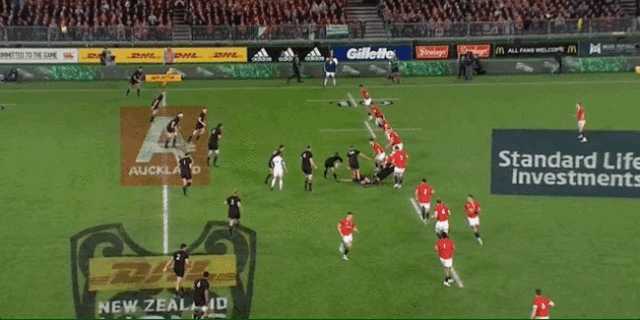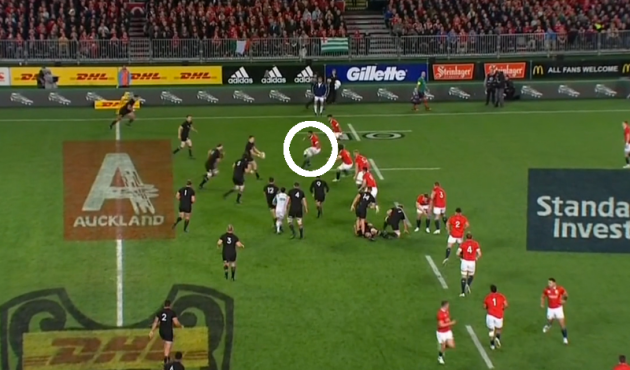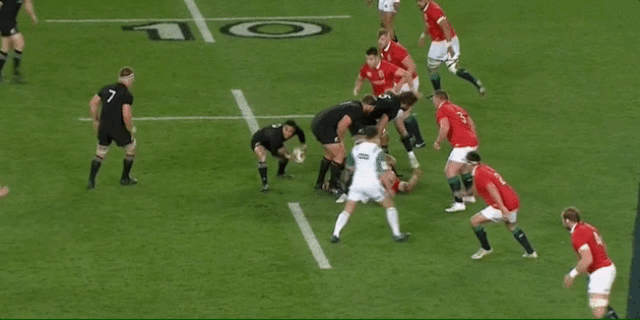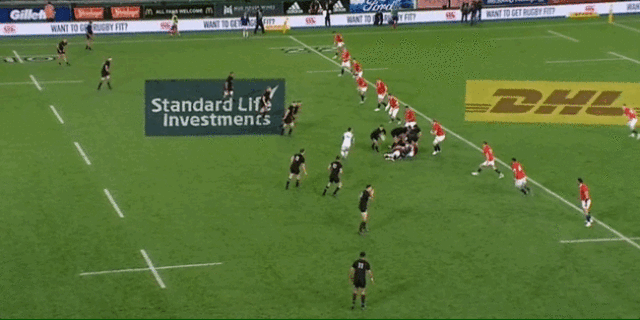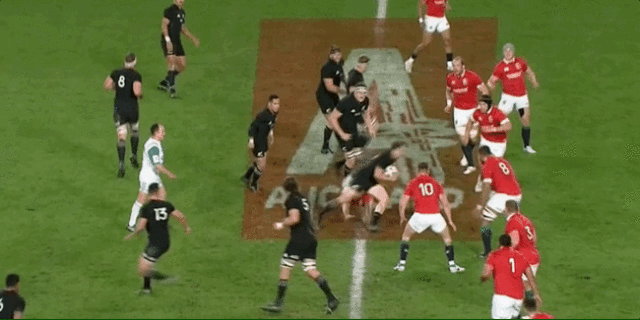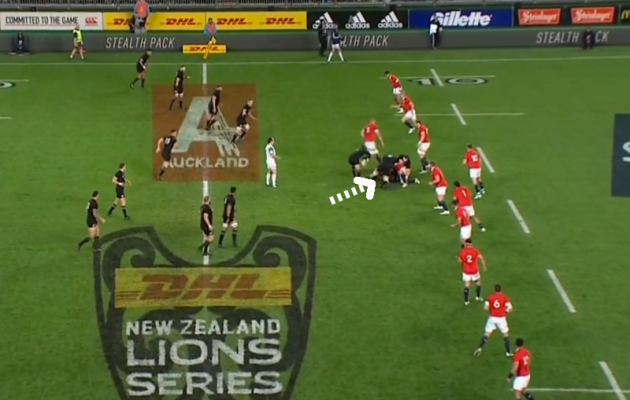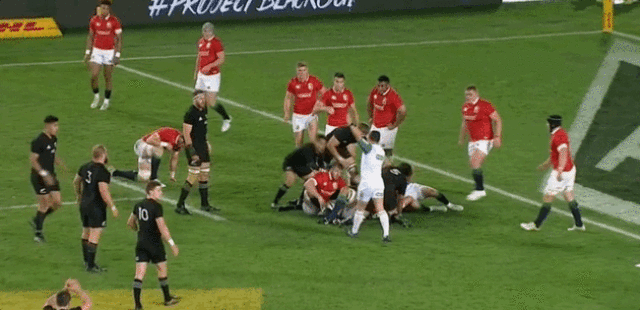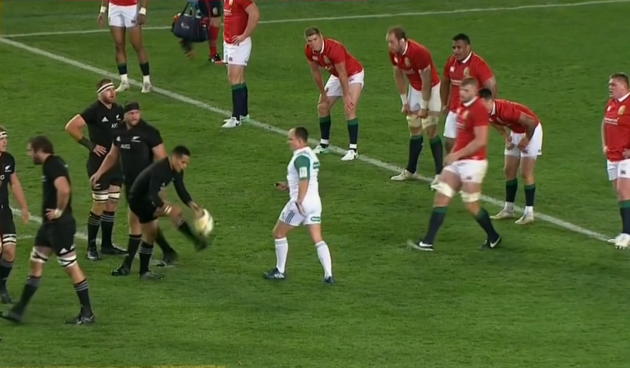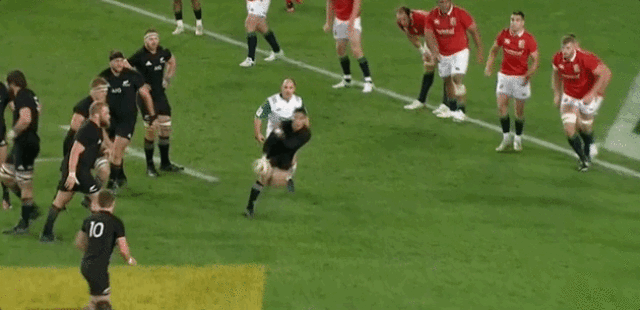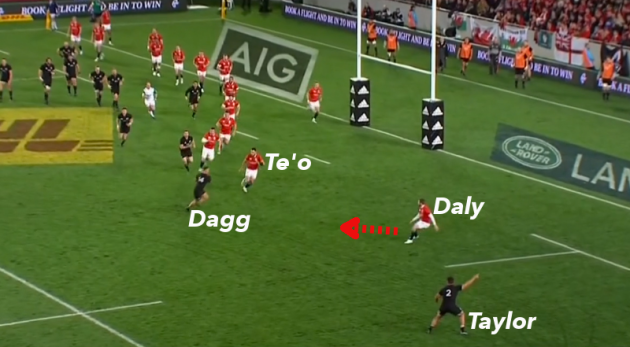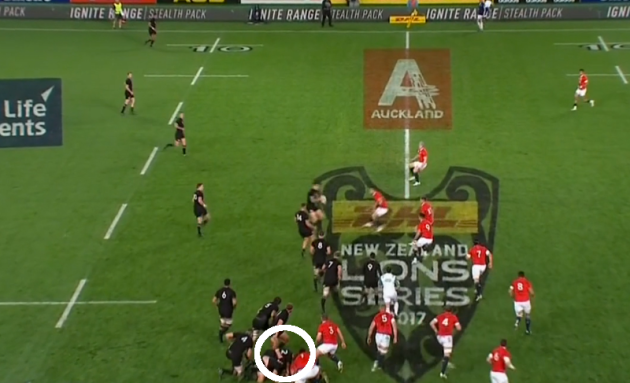WE KNEW THE All Blacks would look to play a high-tempo game against the Lions, but we didn’t know it would come in this form.
Steve Hansen’s side are brilliant at the basics of rugby and we saw some of their handling and finishing prowess in Auckland on Saturday, but this first Test victory was as much about their ability to bring a brutal physical edge.
The Lions couldn’t match it over the course of the 80 minutes and once the Kiwis’ intelligence and rapid decision-making skills were present on top of that foundation of ferocity, Warren Gatland’s side were clearly second best.
Faced with a Lions team they knew would bring aggressive linespeed, the All Blacks came up with a brilliantly simple game plan to attack the tourists at the fringes, with their ruthless ball-carrying and breakdown work allowing them to recycle at a pace that made the Lions uncomfortable.
One of the primary goals for Gatland’s side in the second Test will be to take that pace out of the game, but in the series opener the All Blacks were able to generate lightning-quick ruck speed over the course of long passages of attack.
Their ball-carrying was superb, but on the flip side the Lions were passive in their tackling and there was a glaring absence of big hits, a few thumping efforts from Ben Te’o and a couple of shots from replacement Maro Itoje aside.
It’s easy to complicate rugby games, but this Test match was largely about New Zealand’s ability to beat the Lions in contact repeatedly. If Gatland’s men are to drag themselves back into this series, they must address that issue convincingly in Test two.
Narrow focus
The Lions had expected and prepared for lots of attacking kicking from the All Blacks to counter their linespeed, but aside from an early Beauden Barrett diagonal chip that Anthony Watson dealt with superbly, the Kiwis didn’t really go there.
Instead, their attack was built on relentlessly picking at the seams around the fringes of rucks.
We get an example of that early in the game below.
Beauden Barrett takes the ball from Aaron Smith, and we can see that Taulupe Faletau [circled in white below] has rushed up hard to shut off the outside passing option for the Kiwi out-half.
Instead of attempting to force the ball outside, Barrett turns back the other way for an inside pass – which we saw the All Blacks use frequently. So rather than attempt to play out around the Lions’ linespeed, the Kiwis looked back inside it.
Kieran Read is the player to take the ball from Barrett and here we get a fine example of how the All Blacks won all the inches in this game.
George Kruis has an excellent opportunity to make an early statement with a big hit beyond the gainline, but he misses his tackle on Read.
The All Blacks number eight is clearly determined to breach the gainline and that attitude was key for the hosts at Eden Park, but we must note the technical quality of his carry too, as Read uses his footwork to pirouette back to Kruis’ inside, before powering forward.
We see nice footwork from another Kiwi forward on the next phase, as the All Blacks again stay narrow.
This time, Jamie George leads the Lions’ linespeed as the second defender out from the ruck, but again there is a good decision from an All Black player.
Brodie Retallick sells a dummy, steps back inside before straightening and then reaches out to fend Tadhg Furlong, allowing the New Zealand lock to offload to the supporting Smith.
This is essentially a ‘one-out’ carry for the All Blacks off nine, but Retallick’s rapid decision-making, footwork and skill levels turn it into a linebreak against a slow-reacting Lions defence.
Variety
Already we’ve seen how the All Blacks had more than one tool within their narrow attack and even though there was structure, this attacking game plan was still about the players bringing their vision and decision-making to the fore.
The two phases above provide a further illustration of that, as Barrett opts to carry himself having feinted towards the inside pass option provided by Ben Smith.
The out-half’s carry takes him over the gainline and that means that the Lions have to retreat before setting their defensive line.
Again, the All Blacks’ thinking is too fast for the Lions, as Ben Smith and Aaron Smith play a clever one-two at the right fringe for a half-bust inside Alun Wyn Jones.
The Lions spent so much of this game in this kind of gradual retreat, and that naturally sapped their usual levels of linespeed, which they only truly discovered after the game was already lost.
Brutal breakdown
On top of their ability to get over the gainline with their technically-strong carrying and rapid decision-making, the All Blacks’ had a vicious streak when it came to the rucks.
While they managed to slow and steal the Lions’ possession regularly – playing to Jaco Peyper’s interpretation perfectly – there was an equally effective breakdown focus from New Zealand in attack.
The passage above provides us with a good example of the venomous edge the Kiwis brought to the breakdown.
Ben Smith carries the ball initially and Sean O’Brien looks to be in a good position to jackal after Faletau makes the tackle.
Retallick is on the case, however, and he arrives as first attacking player to the breakdown, dipping to drive into O’Brien before he can properly regain his feet over the tackle.
The truly aggressive edge comes from Whitelock, who arrives in as second man with the ball already being moved away by Aaron Smith.
Whitelock is not really required in this ruck, in truth, but he identifies an opportunity to leave a mark on O’Brien and he takes it aggressively, hammering into the Lions openside.
To be fair to O’Brien, he is back on his feet within two seconds, but this edge from Whitelock is what we saw all night in Auckland and it helped the All Blacks to maintain a tempo that stretched the Lions.
And as we see once again above, the All Blacks continued to pounce close to the rucks – this time through Sam Cane’s inside pass to Ryan Crotty, who offloads to Joe Moody for more big gains.
Finishing touches
Just in case anyone had forgotten, the All Blacks were happy to remind us of their clincial edge in this game too.
None of their tries actually came from the kind of phase play we’ve seen above, but they were all partly or directly a result of the sheer pressure the Kiwis had built with their intelligent narrow attack.
The tap penalty try in the first half finished by hooker Codie Taylor is a prime example of that, as the All Blacks went through 13 phases – including the one above featuring Cane’s inside pass and Crotty’s offload.
The All Blacks exhausted the Lions defence and then pounced when they lapsed in concentration.
We can see the levels of communication from the All Blacks here, as Barrett appeals for Aaron Smith to hit him with the tapped penalty, while Ben Smith further out the line is also calling for the ball.
While the All Blacks are reacting to the picture in front of them, the Lions are deeply fatigued from the effort of defending against the kind of phase play we have discussed.
As we can see above, a number of the Lions players have their hands on their legs or hips sucking in air as scrum-half Smith taps the ball.
To be fair, there are a number of Kiwi players in similar poses, but the Lions are exploited on this occasion as the home side brilliantly shift the ball to space.
Barrett’s skip pass to Isreal Dagg is excellent, allowing the right wing to get to the outside of Ben Te’o and therefore attract Elliot Daly inwards.
While the Lions left wing put his hand up and accepted some culpability in this instance, he’s in a horrible situation with so much space on that side of the pitch, the Lions having failed to spread out evenly after the penalty was awarded – even with a full 10 seconds between Peyper whistling and Smith tapping.
Daly initially bites in towards Dagg, worried that he will break outside Te’o and that leaves him with too much ground to cover when Dagg flings his pass to Taylor wide on the right.
The pick up is obviously sensational, but almost as impressive is the discipline from Taylor to hold his role on that side of the pitch.
If we rewind play to 1 minute and 43 seconds before he dots down, we see Taylor on the ground after the Lions are free-kicked at a scrum for not taking the weight.
The hooker immediately slips into shape and holds the width on the right throughout the entire 14-phase passage.
And even when the penalty is awarded, Taylor doesn’t head back infield to think about a possible lineout or scrum. He maintains his width and gets the reward.
Lions must muscle up
There are technical tweaks for the Lions to make in all areas of their game, but the main issue is the need for Gatland’s side to be more combative and confrontational.
Too often on Saturday they gave up easy yards, as in the instance below.
Kruis and Faletau have a fine chance to make a telling impact beyond the gainline here, but they are passive and again Retallick’s desire to make inches for his team shines through as he fights to get upfield.
The Lions didn’t consistently own the contact in Auckland and that proved key in their defeat. Their work at the defensive breakdown was also an issue and we will look at that element in greater depth elsewhere.
But for Gatland’s side, delivering a more imposing physical impact is a priority for the second Test in Wellington.
The42 is on Instagram! Tap the button below on your phone to follow us!

